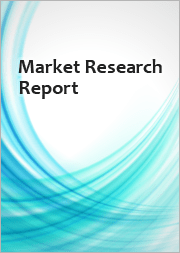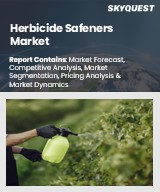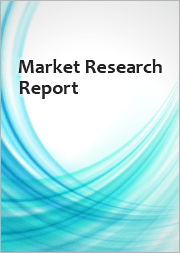
|
시장보고서
상품코드
1734922
세계의 파라콰트 시장 : 제품 유형, 작물 유형, 용도, 최종 사용자, 지역별 분석, 예측(-2032년)Paraquat Market Forecasts to 2032 - Global Analysis By Product Type (Paraquat Aqueous Solution, Paraquat Soluble Granule, Paraquat Water Soluble Gel and Other Product Types), Crop Type, Application, End User and By Geography |
||||||
Stratistics MRC에 따르면 파라콰트 세계 시장은 2025년에 16억 달러, 예측 기간 동안 CAGR 4.8%로 성장하며 2032년에는 22억 달러에 이를 것으로 예측됩니다.
파라콰트는 불필요한 식생을 제어하기 위해 농업에서 널리 사용되는 매우 강력한 제초제입니다. 장기간의 노출은 폐 장애나 파킨슨병과의 관련성 등 심각한 건강 리스크와 관련되어 있습니다.
높은 제초 효율과 글리포세이트에 대한 잡초 저항성
기존의 제초제에 대한 잡초 저항성이 높아짐에 따라, 농가는 즉효성의 메커니즘과 완고한 식물종의 방제 효과를 가지는 파라콰트에 의지하게 되어 왔습니다. 억제 효과적인 작물 보호 방법의 필요성에 의해 더욱 높아지고 있습니다. 또한, 수확 전의 작물 건조에 있어서의 파라콰트의 역할은 특히 집약적인 농업을 실시하는 지역에서 시장에서의 지위를 강화하고 있습니다.
인축에 강한 독성이 있고 우발적 및 의도적인 중독이 있습니다.
흡입, 섭취, 피부 접촉으로 인한 우발적 노출은 치명적인 중독을 일으킬 수 있으며 보건 당국간에 우려가 높아지고 있습니다. 이로 인해 규제 강화가 요구되고 있으며, 그 결과 여러 국가에서 사용 금지 및 단계적인 사용 폐지가 실시되어 환경 및 위생 규제가 엄격한 지역에서 시장 성장이 제한되고 있습니다.
종합잡초관리(IWM) 시스템의 진보
파라콰트와 정밀농업기술과 선택적 제초제 살포를 조합함으로써 환경에 미치는 영향을 줄이면서 효율을 향상시킬 수 있습니다. 농업이 보다 스마트한 솔루션으로 전환하는 동안 종합적인 잡초 방제 전략에서 파라콰트의 역할은 특히 대규모 상업 농업에서 여전히 중요할 것으로 예측됩니다.
바이오 제초제 및 보다 안전한 대체 화학 물질의 가용성 향상
지속가능한 농업과 환경보전에 대한 의식이 높아짐에 따라 생태계에 대한 영향을 최소화한 무해한 제초제에 대한 수요를 촉진하고 있습니다., 환경 친화적인 대체품으로의 전환이 촉진되고 있습니다. 규제의 압력과보다 안전한 농업 투입물에 대한 소비자의 선호도의 진화는 앞으로 몇 년 동안 파라콰트 시장의 확대를 더욱 어렵게 만들 수 있습니다.
COVID-19의 영향 :
COVID-19의 큰 유행은 공급망을 혼란시키고 농업 생산 동향을 변화시킴으로써 파라콰트 시장에 영향을 미쳤습니다. 이로 인해 효과적인 잡초 관리 솔루션에 대한 수요는 안정적이었습니다.
예측 기간 동안 파라콰트 수용액 부문이 최대가 될 전망
파라콰트 수용액 부문은 그 살포의 용이성과 잡초 방제의 효능에 의해 예측 기간 중 최대 시장 점유율을 차지할 것으로 예측됩니다. 합성에 의해 대규모 농업에서 널리 채용되고 있습니다.또한, 액체 제제의 기술 혁신에 의해 사용성이 향상되어, 파라콰트는 출아 전 및 출아 후의 잡초 관리의 양쪽 모두에 있어서 효율적인 선택이 되고 있습니다.
예측 기간 동안 건조제 부문의 CAGR이 가장 높을 것으로 예측됩니다.
예측 기간 동안 건조제 분야가 가장 높은 성장률을 보일 것으로 예상되는 것은 수확 전의 효율적인 작물 건조 솔루션에 대한 요구가 높아지면서 파라콰트 기반의 건조제 수요를 밀어 올리고 있기 때문입니다.
최대 공유 지역 :
예측 기간 동안 북미가 가장 큰 시장 점유율을 차지할 것으로 예상되는데, 이는 지역의 확립된 농업 부문과 첨단 농업 기술에 대한 의존으로 인한 것입니다. 파라콰트와 같은 효과적인 제초제의 채용을 촉진하고, 왕성한 수요를 유지하고 있습니다. 또한, 연구개발에 대한 투자가 제초제 처방의 개량을 촉진해, 규제 가이드라인에의 준거를 확실히 하고 있습니다.
CAGR이 가장 높은 지역 :
예측 기간 동안 아시아태평양이 가장 높은 CAGR을 나타낼 것으로 예측됩니다. 광대한 농지와 비용 효율적인 잡초 관리 솔루션의 필요성으로 인해 사용량이 증가하고 있습니다.
무료 사용자 정의 서비스:
이 보고서를 구독하는 고객은 다음 무료 맞춤설정 옵션 중 하나를 사용할 수 있습니다.
- 기업 프로파일
- 추가 시장 기업의 종합적 프로파일링(3개사까지)
- 주요 기업의 SWOT 분석(3개사까지)
- 지역 세분화
- 고객의 관심에 응한 주요국 시장 추정, 예측 및 CAGR(주 : 타당성 확인에 따름)
- 경쟁 벤치마킹
- 제품 포트폴리오, 지리적 존재, 전략적 제휴에 기반한 주요 기업 벤치마킹
목차
제1장 주요 요약
제2장 서문
- 개요
- 이해관계자
- 조사 범위
- 조사 방법
- 데이터 마이닝
- 데이터 분석
- 데이터 검증
- 조사 접근
- 조사 자료
- 1차 조사 자료
- 2차 조사 정보원
- 전제조건
제3장 시장 동향 분석
- 성장 촉진요인
- 억제요인
- 기회
- 위협
- 제품분석
- 용도 분석
- 최종 사용자 분석
- 신흥 시장
- COVID-19의 영향
제4장 Porter's Five Forces 분석
- 공급기업의 협상력
- 구매자의 협상력
- 대체품의 위협
- 신규 참가업체의 위협
- 경쟁 기업간 경쟁 관계
제5장 세계의 파라콰트 시장 : 제품 유형별
- 파라콰트 수용액
- 파라콰트 가용성 과립
- 파라콰트 수용성 겔
- 기타 제품 유형
제6장 세계의 파라콰트 시장 : 작물 유형별
- 곡물
- 과일 및 채소
- 지방종자 및 콩류
- 농장작물
- 기타 작물 유형
제7장 세계의 파라콰트 시장 : 용도별
- 제초제
- 건조제
- 고엽제
- 식물성장조정제
- 비농업 잡초 방제
- 농장
- 기타 용도
제8장 세계의 파라콰트 시장 : 최종 사용자별
- 상업농가
- 농약 판매자
- 정부 및 지방자치단체
제9장 세계의 파라콰트 시장 : 지역별
- 북미
- 미국
- 캐나다
- 멕시코
- 유럽
- 독일
- 영국
- 이탈리아
- 프랑스
- 스페인
- 기타 유럽
- 아시아태평양
- 일본
- 중국
- 인도
- 호주
- 뉴질랜드
- 한국
- 기타 아시아태평양
- 남미
- 아르헨티나
- 브라질
- 칠레
- 기타 남미
- 중동 및 아프리카
- 사우디아라비아
- 아랍에미리트(UAE)
- 카타르
- 남아프리카
- 기타 중동 및 아프리카
제10장 주요 발전
- 계약, 파트너십, 협업, 합작투자
- 인수와 합병
- 신제품 발매
- 사업 확대
- 기타 주요 전략
제11장 기업 프로파일링
- ADAMA Agricultural Solutions Ltd.
- AgFarm
- Bayer AG
- Canary Agro Chemicals Private Limited
- Corteva
- Dhanuka Agritech Ltd.
- FMC
- Hubei Sanonda Co., Ltd
- Jiangsu Yangnong Chemical
- Nantong Jiangshan Agrochemical
- Shandong Luba Chemical
- Sinon Corporation
- Syngenta Crop Protection AG
- Toshi Automatic Systems
- UPL Ltd
- Willowood USA
- Zhejiang Xinan Chemical Industrial
According to Stratistics MRC, the Global Paraquat Market is accounted for $1.6 billion in 2025 and is expected to reach $2.2 billion by 2032 growing at a CAGR of 4.8% during the forecast period. Paraquat is a highly potent herbicide widely used in agriculture for controlling unwanted vegetation. As a non-selective contact herbicide, it eliminates most plant species upon direct exposure by disrupting photosynthesis, leading to rapid dehydration. Due to its extreme toxicity, even minimal exposure whether through ingestion, inhalation, or skin contact can be fatal to humans. Prolonged exposure has been associated with severe health risks, including lung damage and a potential link to Parkinson's disease. While many countries have imposed strict regulations or bans on its use, Paraquat remains prevalent in certain regions. Proper handling, protective equipment, and adherence to safety protocols are essential to minimize risks.
Market Dynamics:
Driver:
High herbicidal efficiency & weed resistance to glyphosate
As weed resistance to conventional herbicides increases, farmers are relying on Paraquat for its fast-acting mechanism and effectiveness in controlling stubborn plant species. This demand is further fueled by the need for efficient crop protection methods that enhance yield and minimize losses. Additionally, its role in pre-harvest crop desiccation has strengthened its position in the market, particularly in regions with intensive farming practices.
Restraint:
Highly toxic to humans and animals, with accidental and intentional poisonings
Accidental exposure through inhalation, ingestion, or skin contact can result in fatal poisoning, raising concerns among health authorities. Additionally, cases of intentional poisoning have highlighted the dangers associated with its availability, prompting calls for tighter restrictions. As a result, several countries have imposed bans or phased out its usage, limiting market growth in regions with stringent environmental and health regulations.
Opportunity:
Advancements in integrated weed management (IWM) systems
Combining Paraquat with precision farming techniques and selective herbicide application can improve efficiency while reducing environmental impact. Additionally, research into safer formulations and improved application methods is helping address safety concerns associated with its use. As farming transitions toward smarter solutions, Paraquat's role in comprehensive weed control strategies is expected to remain relevant, particularly in large-scale commercial agriculture.
Threat:
Growing availability of bio-herbicides and safer chemical alternatives
Growing awareness of sustainable farming and environmental conservation is driving demand for non-toxic herbicides with minimal ecological consequences. Additionally, advancements in organic weed control methods are reducing dependence on synthetic chemicals, prompting a shift toward eco-friendly alternatives. Regulatory pressures and evolving consumer preferences for safer agricultural inputs may further challenge Paraquat's market expansion in the coming years.
Covid-19 Impact:
The COVID-19 pandemic impacted the Paraquat market by disrupting supply chains and altering agricultural production trends. While initial lockdowns led to logistical challenges, the demand for effective weed management solutions remained steady as food security became a priority. Farmers sought reliable herbicides to ensure consistent crop yields amid labor shortages, sustaining Paraquat's usage across various regions.
The paraquat aqueous solution segment is expected to be the largest during the forecast period
The paraquat aqueous solution segment is expected to account for the largest market share during the forecast period due to its ease of application and effectiveness in weed control. Its widespread adoption across large-scale farming operations is driven by its rapid action and compatibility with modern spraying systems. Additionally, innovations in liquid formulations are enhancing usability, making Paraquat an efficient choice for both pre-emergent and post-emergent weed management.
The desiccant segment is expected to have the highest CAGR during the forecast period
Over the forecast period, the desiccant segment is predicted to witness the highest growth rate owing to the increasing need for efficient crop drying solutions before harvest has boosted demand for Paraquat-based desiccants. Farmers utilize these solutions to accelerate crop maturation, ensuring uniform drying and improved yield quality. This trend is particularly significant in grain-producing regions where timely harvest cycles are critical.
Region with largest share:
During the forecast period, the North America region is expected to hold the largest market share supported by the region's well-established agricultural sector and reliance on advanced farming techniques. Large-scale commercial farms and extensive row-crop cultivation drive the adoption of effective herbicides like Paraquat, maintaining strong demand. Additionally, investments in research and development are facilitating the improvement of herbicide formulations, ensuring compliance with regulatory guidelines.
Region with highest CAGR:
Over the forecast period, the Asia Pacific region is anticipated to exhibit the highest CAGR because of the expanding agricultural activities, rising food demand, and increasing herbicide adoption contribute to the rapid growth. Countries like China, India, and Indonesia are seeing heightened usage due to their vast farming landscapes and the need for cost-effective weed management solutions. Government initiatives supporting enhanced agricultural productivity and weed control practices further reinforce market expansion across the region.
Key players in the market
Some of the key players in Paraquat Market include ADAMA Agricultural Solutions Ltd., AgFarm, Bayer AG, Canary Agro Chemicals Private Limited, Corteva, Dhanuka Agritech Ltd., FMC, Hubei Sanonda Co., Ltd, Jiangsu Yangnong Chemical, Nantong Jiangshan Agrochemical, Shandong Luba Chemical, Sinon Corporation, Syngenta Crop Protection AG, Toshi Automatic Systems, UPL Ltd, Willowood USA, and Zhejiang Xinan Chemical Industrial.
Key Developments:
In February 2025, yngenta acquired a repository of natural compounds and genetic strains from Novartis to enhance its biologic crop protection development. This strategic acquisition includes leasing a fermentation pilot plant and laboratories in Basel.
In November 2024, Dhanuka Agritech Ltd. signed an agreement with Bayer AG, Germany, for the acquisition of active ingredients named "Iprovalicarb" and "Triadimenol". This strategic move aims to expand Dhanuka's product portfolio and strengthen its position in the agrochemical market.
Product Types Covered:
- Paraquat Aqueous Solution
- Paraquat Soluble Granule
- Paraquat Water Soluble Gel
- Other Product Types
Crop Types Covered:
- Cereals & Grains
- Fruits & Vegetables
- Oilseeds & Pulses
- Plantation Crops
- Other Crop Types
Applications Covered:
- Herbicide
- Desiccant
- Defoliant
- Plant Growth Regulator
- Non-Agricultural Weed Control
- Farms
- Other Applications
End Users Covered:
- Commercial Farmers
- Agrochemical Distributors
- Government & Municipal Bodies
Regions Covered:
- North America
- US
- Canada
- Mexico
- Europe
- Germany
- UK
- Italy
- France
- Spain
- Rest of Europe
- Asia Pacific
- Japan
- China
- India
- Australia
- New Zealand
- South Korea
- Rest of Asia Pacific
- South America
- Argentina
- Brazil
- Chile
- Rest of South America
- Middle East & Africa
- Saudi Arabia
- UAE
- Qatar
- South Africa
- Rest of Middle East & Africa
What our report offers:
- Market share assessments for the regional and country-level segments
- Strategic recommendations for the new entrants
- Covers Market data for the years 2024, 2025, 2026, 2028, and 2032
- Market Trends (Drivers, Constraints, Opportunities, Threats, Challenges, Investment Opportunities, and recommendations)
- Strategic recommendations in key business segments based on the market estimations
- Competitive landscaping mapping the key common trends
- Company profiling with detailed strategies, financials, and recent developments
- Supply chain trends mapping the latest technological advancements
Free Customization Offerings:
All the customers of this report will be entitled to receive one of the following free customization options:
- Company Profiling
- Comprehensive profiling of additional market players (up to 3)
- SWOT Analysis of key players (up to 3)
- Regional Segmentation
- Market estimations, Forecasts and CAGR of any prominent country as per the client's interest (Note: Depends on feasibility check)
- Competitive Benchmarking
- Benchmarking of key players based on product portfolio, geographical presence, and strategic alliances
Table of Contents
1 Executive Summary
2 Preface
- 2.1 Abstract
- 2.2 Stake Holders
- 2.3 Research Scope
- 2.4 Research Methodology
- 2.4.1 Data Mining
- 2.4.2 Data Analysis
- 2.4.3 Data Validation
- 2.4.4 Research Approach
- 2.5 Research Sources
- 2.5.1 Primary Research Sources
- 2.5.2 Secondary Research Sources
- 2.5.3 Assumptions
3 Market Trend Analysis
- 3.1 Introduction
- 3.2 Drivers
- 3.3 Restraints
- 3.4 Opportunities
- 3.5 Threats
- 3.6 Product Analysis
- 3.7 Application Analysis
- 3.8 End User Analysis
- 3.9 Emerging Markets
- 3.10 Impact of Covid-19
4 Porters Five Force Analysis
- 4.1 Bargaining power of suppliers
- 4.2 Bargaining power of buyers
- 4.3 Threat of substitutes
- 4.4 Threat of new entrants
- 4.5 Competitive rivalry
5 Global Paraquat Market, By Product Type
- 5.1 Introduction
- 5.2 Paraquat Aqueous Solution
- 5.3 Paraquat Soluble Granule
- 5.4 Paraquat Water Soluble Gel
- 5.5 Other Product Types
6 Global Paraquat Market, By Crop Type
- 6.1 Introduction
- 6.2 Cereals & Grains
- 6.3 Fruits & Vegetables
- 6.4 Oilseeds & Pulses
- 6.5 Plantation Crops
- 6.6 Other Crop Types
7 Global Paraquat Market, By Application
- 7.1 Introduction
- 7.2 Herbicide
- 7.3 Desiccant
- 7.4 Defoliant
- 7.5 Plant Growth Regulator
- 7.6 Non-Agricultural Weed Control
- 7.7 Farms
- 7.8 Other Applications
8 Global Paraquat Market, By End User
- 8.1 Introduction
- 8.2 Commercial Farmers
- 8.3 Agrochemical Distributors
- 8.4 Government & Municipal Bodies
9 Global Paraquat Market, By Geography
- 9.1 Introduction
- 9.2 North America
- 9.2.1 US
- 9.2.2 Canada
- 9.2.3 Mexico
- 9.3 Europe
- 9.3.1 Germany
- 9.3.2 UK
- 9.3.3 Italy
- 9.3.4 France
- 9.3.5 Spain
- 9.3.6 Rest of Europe
- 9.4 Asia Pacific
- 9.4.1 Japan
- 9.4.2 China
- 9.4.3 India
- 9.4.4 Australia
- 9.4.5 New Zealand
- 9.4.6 South Korea
- 9.4.7 Rest of Asia Pacific
- 9.5 South America
- 9.5.1 Argentina
- 9.5.2 Brazil
- 9.5.3 Chile
- 9.5.4 Rest of South America
- 9.6 Middle East & Africa
- 9.6.1 Saudi Arabia
- 9.6.2 UAE
- 9.6.3 Qatar
- 9.6.4 South Africa
- 9.6.5 Rest of Middle East & Africa
10 Key Developments
- 10.1 Agreements, Partnerships, Collaborations and Joint Ventures
- 10.2 Acquisitions & Mergers
- 10.3 New Product Launch
- 10.4 Expansions
- 10.5 Other Key Strategies
11 Company Profiling
- 11.1 ADAMA Agricultural Solutions Ltd.
- 11.2 AgFarm
- 11.3 Bayer AG
- 11.4 Canary Agro Chemicals Private Limited
- 11.5 Corteva
- 11.6 Dhanuka Agritech Ltd.
- 11.7 FMC
- 11.8 Hubei Sanonda Co., Ltd
- 11.9 Jiangsu Yangnong Chemical
- 11.10 Nantong Jiangshan Agrochemical
- 11.11 Shandong Luba Chemical
- 11.12 Sinon Corporation
- 11.13 Syngenta Crop Protection AG
- 11.14 Toshi Automatic Systems
- 11.15 UPL Ltd
- 11.16 Willowood USA
- 11.17 Zhejiang Xinan Chemical Industrial



















